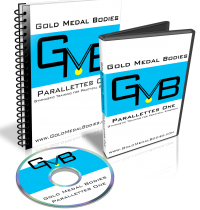Ryan Hurst from Gold Medal Bodies is here to show you how to build a training foundation with parallettes. This is the first of a three part series.
If you’ve ever seen a gymnast perform skills like the planche, you’ve probably wished you could too. Maybe you even got right down on the floor and tried one. Then looked around to make sure nobody was watching after you landed on your face.
Most of the classic bodyweight feats of strength are really damn hard (that’s why they’re called “feats of strength”), but with the right foundation, there’s no reason they can’t be achievable. But how do you build that foundation? Surely, if it were as simple as doing more bench presses, you’d see a lot more people who could perform a planche.
There’s a right tool for every job, and the tool gymnasts use to build upper-body strength for floor work is a set of parallettes.
Parallettes are great for a number of reasons. Not only do they allow greater stability and leverage than our hands have on the floor (which makes it easier to practice many skills), they’re small, light, and easy to build for yourself.
Everyone knows that pushing exercises are key for practical upper body strength, but what you may not know is how basic pressing can lay the foundation for more sophisticated, full-body movements, and parallettes are an ideal tool to help bridge that gap.
In recent years, parallettes have been adopted primarily by CrossFitters, owing primarily to their portability and cost. Unfortunately, the information on the web about parallette training is limited and simplistic. A quick check on YouTube shows tons of videos of people performing maybe three or four different parallette exercises, usually with poor form.
So let’s start there – by learning one high-leverage exercise with perfect form.
Enter The Parallette Push-Up
“Just a push-up?”
When you focus on your form and pay attention to finer details of the movement, you’ll find that doing correct push-ups on parallettes can be much more challenging than you’d expect.
As a reminder:
• Keep your elbows tight in to your side, with hands slightly wider than shoulder width. Shoulders stay over your hands and don’t let them drop below the level of the bar on the bottom of the repetition.
• Push and drive your elbow pits facing forward.
• A three second hold on the bottom and top position, with a locked down core, tight butt and legs will create a whole body tension, and make this into a full body exercise.
This exercise can be performed daily if repetitions are kept low (not more than 5 repetitions in a set).
We’ll have another video in a couple of days that builds on this foundation and really tightens up your core strength for more dynamic movements.
Until then, give these a shot and be sure to leave a comment and let us know how you like ‘em. Do you still think they’re “just push-ups?”
Gold Medal Bodies has a full blown course on Parallette Training.





this excercise looks good, im training for a planche and am getting really close at the moment, i’ll be sure to give this a try
so I have fallen in love with the idea of hand balancing and I noticed that the men and women doing it are extremely flexible….I am somewhat flexible… I know with a few months work I should be able to do a split to the floor..I get about a foot to 6 inches from it after some stretching right now depending on the type of split…but I was wondering what types of classes or exercises are recommended to help increase this…I am working at home but really have no outlet otherwise that I can think of….I would love any advice…I am allready working on parallettes and my handstands. do you think dance or yoga or…..? i dunno would help with my flexibility. thanks
@missi: Some exercises need more flexibility than others. Flexibility is a very specific thing as far as where and how flexible you are. So let’s say you’re working on the press handstand for instance. You do need hamstring and hip flexibility. Working towards the exercise will give you that. Also working on the pancake stretch, where your legs are spread out and your reach your torso to the floor will help. General flexibility is good but look at what you’re specifically trying to achieve.
Sure sounds good… i wish i wasn’t so broke. 🙁